
Today, let’s use it step by stepAIto make a product.
Includes tool recommendations and 10 complete product design version 1.0 prompts.
The product effect we made today can be a small red book operation toolbox like this:
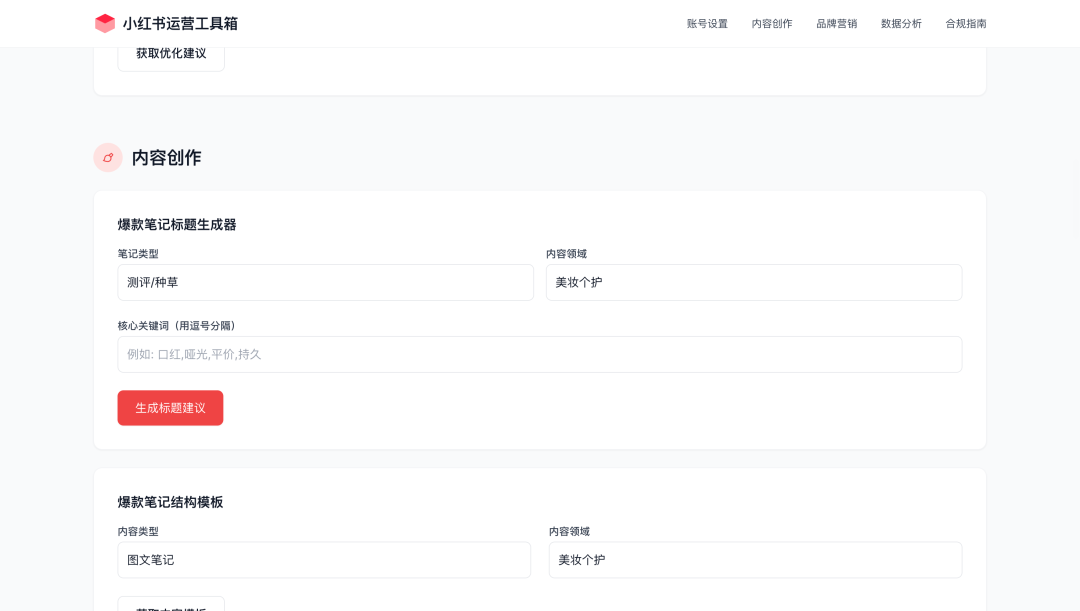
It can also be a long short video hit prediction analysis:
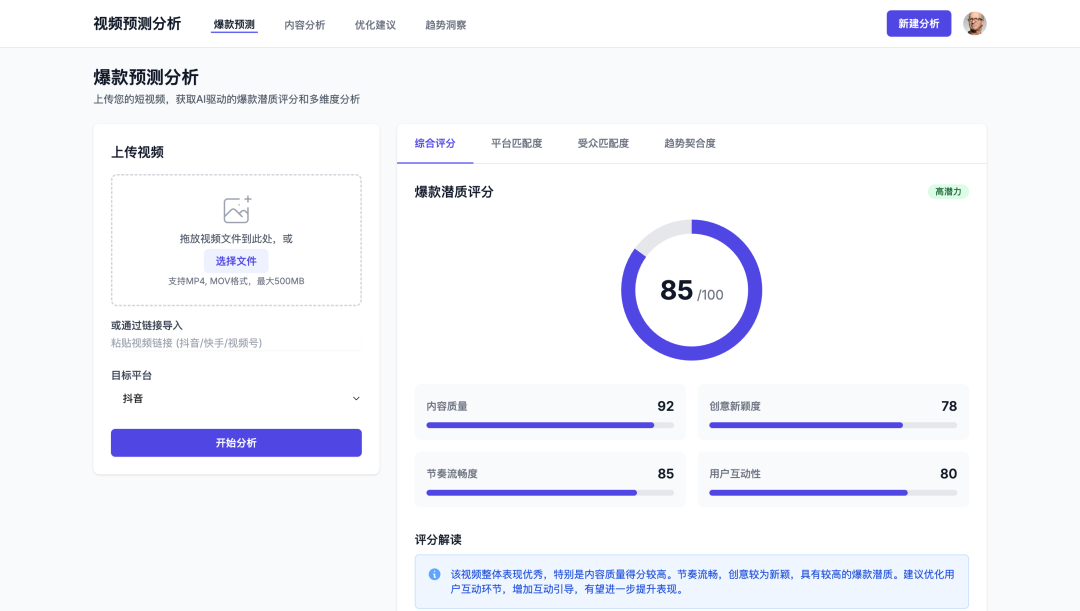
It can also be a product introduction interface like this:
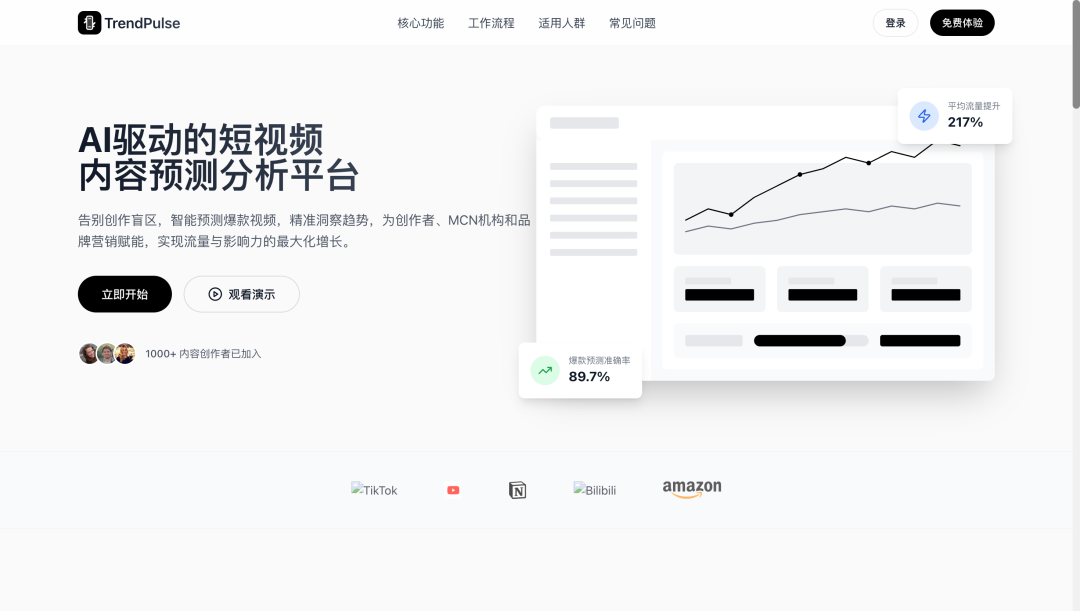
Don’t worry, the content of today’s article will take you step by step to complete the products that can really be used.
atAIEra, everyone isProduct Manager。
From understanding needs, brainstorming, user insights, functional combing, to document writing, code docking, and even product introduction and marketing copy. We also let the model understand the interface we designed, and as long as we drop the Figma link, it will automatically understand and continue working.
Today’s sharing is mainly around the dismantling of a certain competition question (demand), talking about how we make a complete product step by step, starting from a topic.
During the live broadcast of WayatoAGI, we used Amazon Q, an AI IDE task, to assist in the entire process, and you can also use the tools of Trae, Cursor, and Windsurf.
I will break down these steps into practical processes to share with you, and I hope you can also use these methods during the competition to really save time and focus on creativity.
For example, I made an app called Pailido before, which is essentially an AI-based instant camera.
The bottom layer of this product is throughMultimodal AI VolumeDriven, realizes the intelligent linkage between images and text. When using it, I only need to choose different application scenarios, such as: Xiaohongshu copywriting, salted fish copywriting, takeaway reviews and other stylized templates.
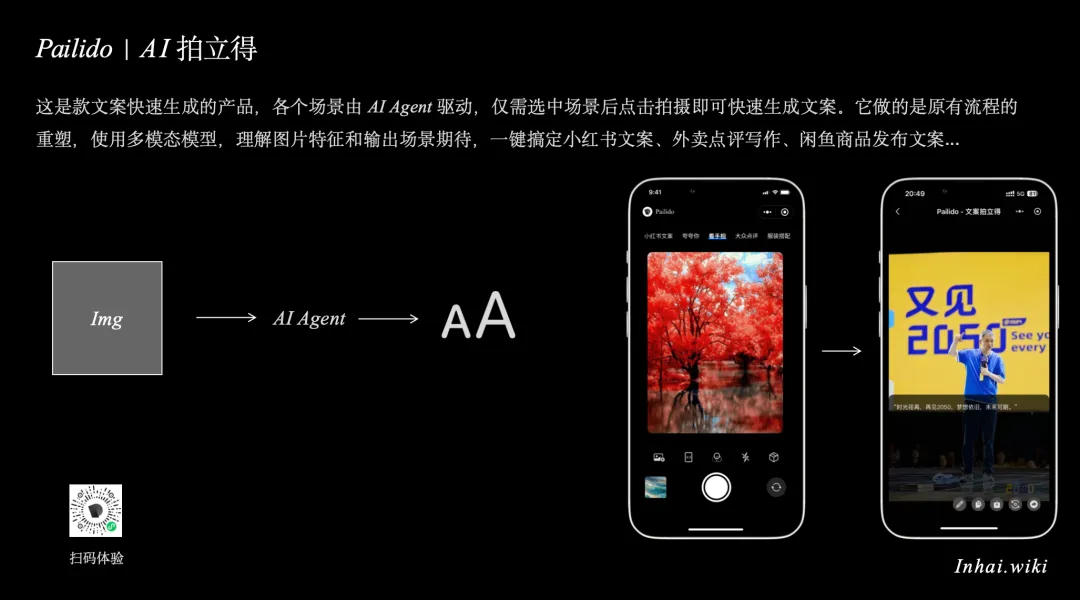
Then, just point at the scene, click to take a photo, and the camera canAccording to the current screen content, the corresponding style of copywriting is automatically generated。
What it really achieves is oneFrom determining the scene to determining the textThe efficient process greatly improves the convenience of the experience. Compared with the traditional method – you need to upload images first, then manually write prompts, and then call the large model to generate, and the whole process takes at least two steps.
And in Polaroid, I just needSelect a scene and shoot it once, you can directly get the expected results. Essentially, what this product does is in AI interactionGreatly shorten the originally cumbersome process, making the experience more natural, instant, and efficient.
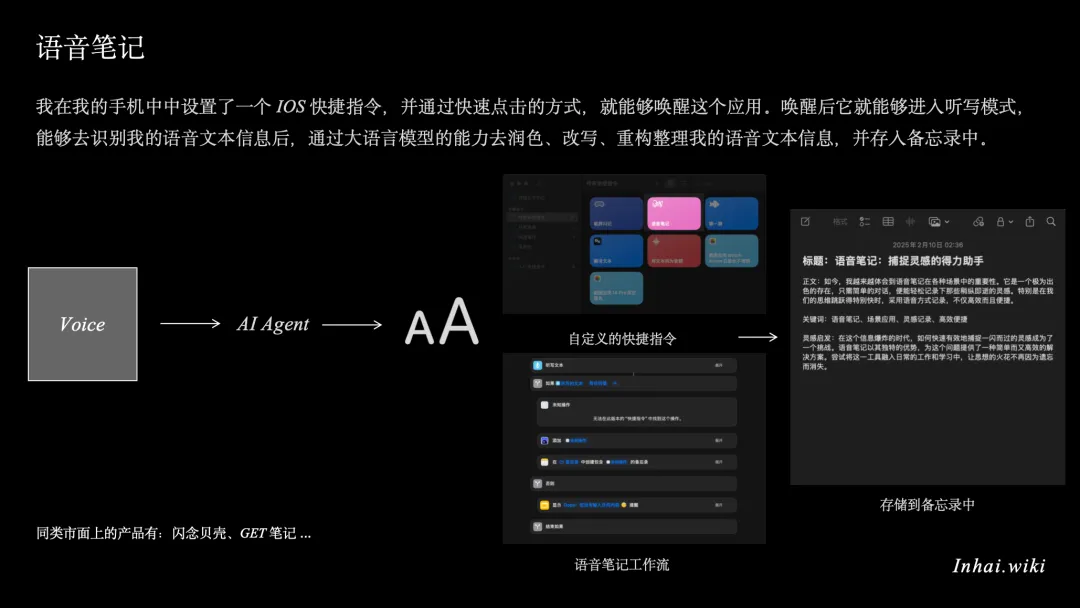
I also tried a new thing at front-end time – developed oneVoice notesFunction. On my phone, I set one by setting oneiOS is fastdirectives, just a few quick clicks to wake up the app with one click, and then directly talk to it.
I just need toSpeak out what is in your mindIt can be quickly recorded, and the content can be automatically organized and written into the memo.
Of course, in order to improve the accuracy of records and the convenience of searching, I also preset a lot of prompts, keyword matching logic, and inspiration settings at the bottom. This way, when I need to find a note, I can locate the corresponding content faster.
As for the root of demand, why do you do this? Because I discovered,I think much faster than I can type。
For example, I can think of about 100 words in a minute, but if I type, I may not be able to finish 50 words in a minute, and my thoughts are easily interrupted and the order may be confused. And through thisVoice input +Large modelPolishing and organizingNot only does it record faster, but it also makes the content smoother and more organized.
Of course, in addition to voice notes, there is also a very hot topic recently – that is, everyone is talking and laughingVibe Coding, that isAIprogramming。
This emerging way is inProfoundly reshape the design logic of the entire product。
For example, my personal homepage is pure AI to assist us in completing it~
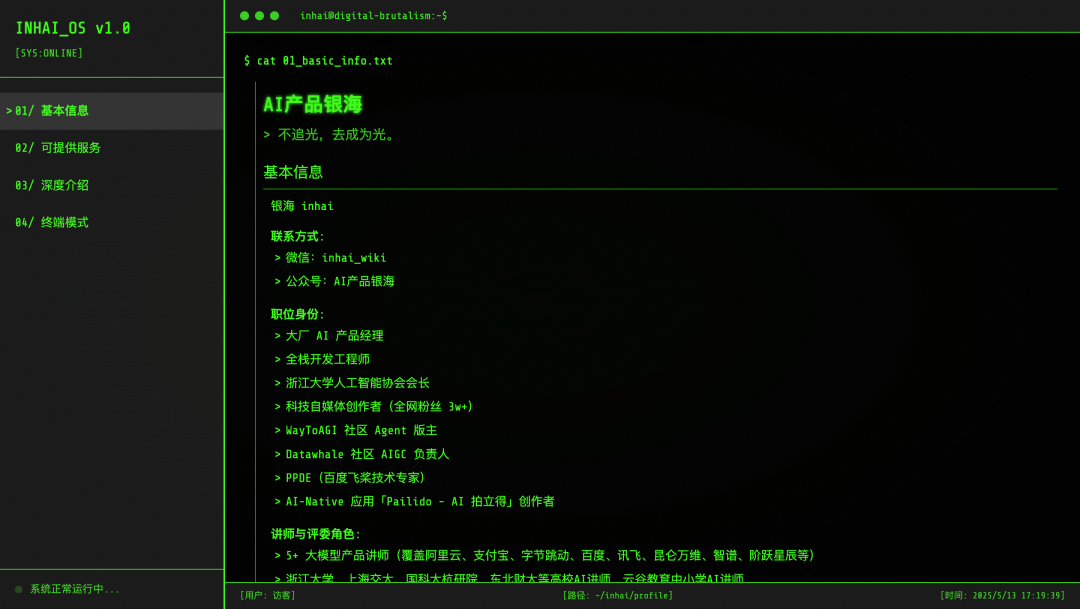
You can use a product like flowith to help you quickly verify your product ideas and demosXiaohongshu’s operational toolbox.
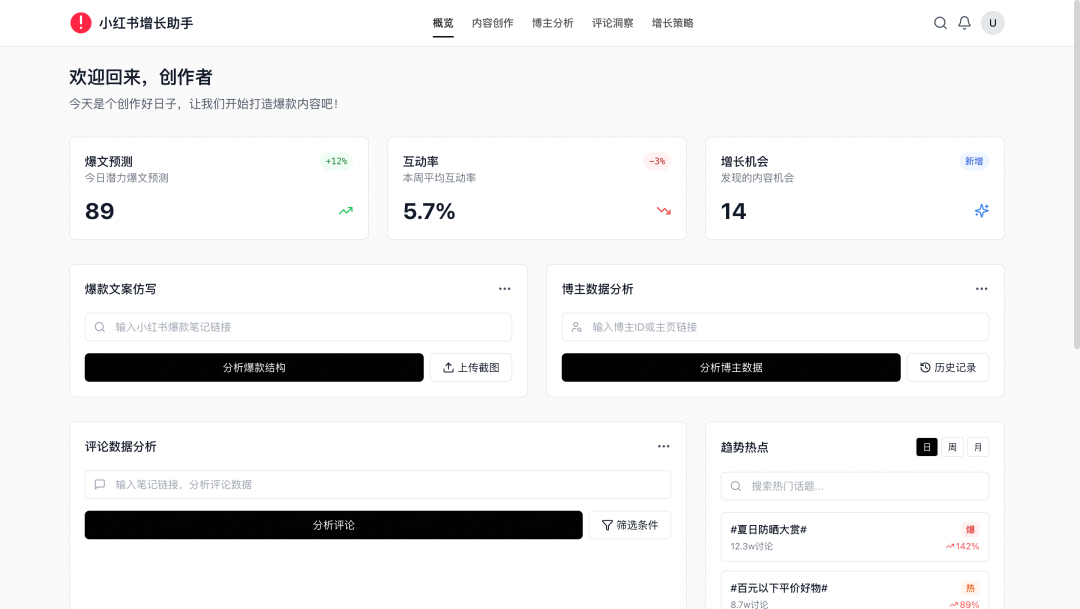
The above interface shows the link: https://flo.host/njMdn-z/
This series of AI-native applications is quietly changing the way we live and work in various fields. They don’t simply overlay AI capabilities on top of existing software, but start from the ground up, redefining interactions and workflows, bringing a completely different experience from traditional applications.
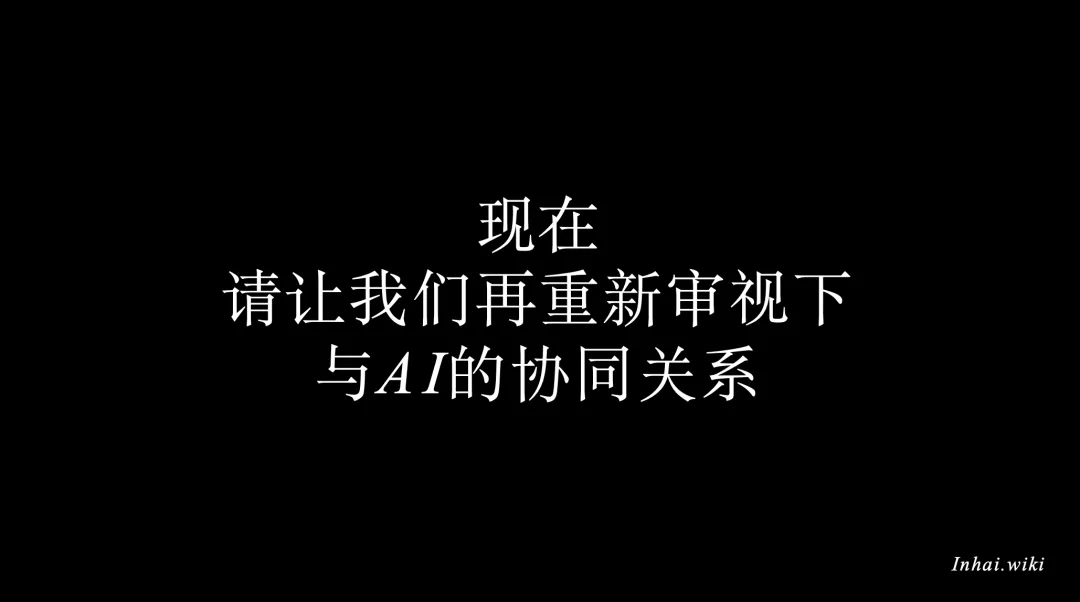
In the past, we had to manually write a lot of code and build product prototypes step by step.
Now, by collaborating with AI, we only need to describe ideas in natural language, and AI can assist in generating underlying code, building interfaces, and optimizing interaction logic.
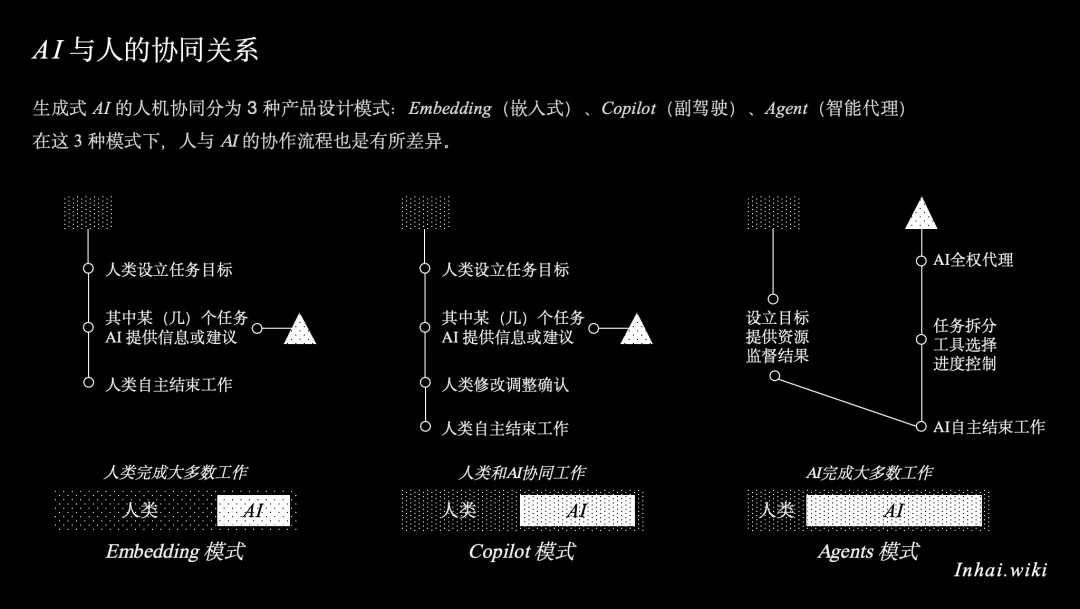
Next, let’s take a look, inAIeraunderNew workflow designHow will it change?
In the future, many times we just need to be simpleVerbal expression of needsLike what:
- “Help me complete a requirements document.”
- “Help me design an interview outline on a certain topic.”
- “Guide me on how to organize the user journey map.”
- “I have a simple feature requirements document and hope to help me quickly generate interfaces directly through Vibe Coding.”
- “Help me complete a PPT with a complete structure and professional visuals.”
In the past, these scenarios often required multiple rounds of communication and manual production for product managers, designers, operations, engineers and other roles, but now, with the blessing of AI,Just a one-sentence description, the system can understand the intention, automatically complete the tedious links in the middle, and directly produce high-quality results.
It can be seen that such a process design has beenVery close to our natural way of thinking– No longer write requirements documents first, then develop, and then adjust
From idea to finished product, it is almost seamless。
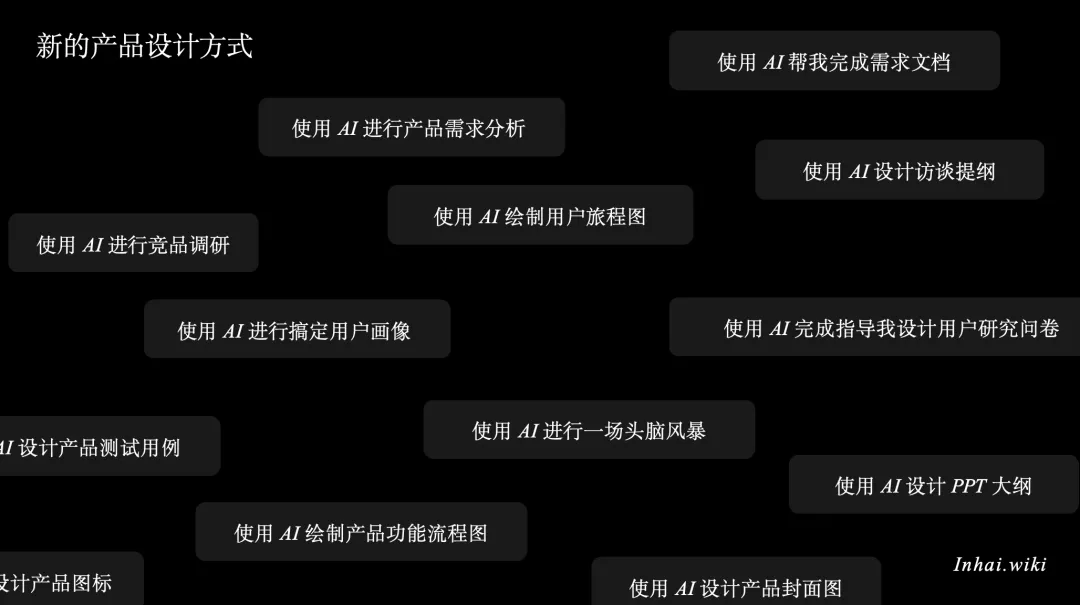
Below, we will use AI step by step to assist us in making a complete product.
1. Find out what we are going to do first
Let AI help us break down the content of our needs
As soon as you get the competition questions, it’s actually quite easy to look dazed. The topic is complicated, and there are a lot of words, and I still can’t grasp the key points after reading it several times. At this time, throw the competition content to Amazon Q, and it will help us figure out the logic.
For example: What problem does the question solve? Are there any restrictions? What are the judging criteria? It can help us disassemble it step by step, which is equivalent to understanding the direction first, and don’t work blindly from the beginning.
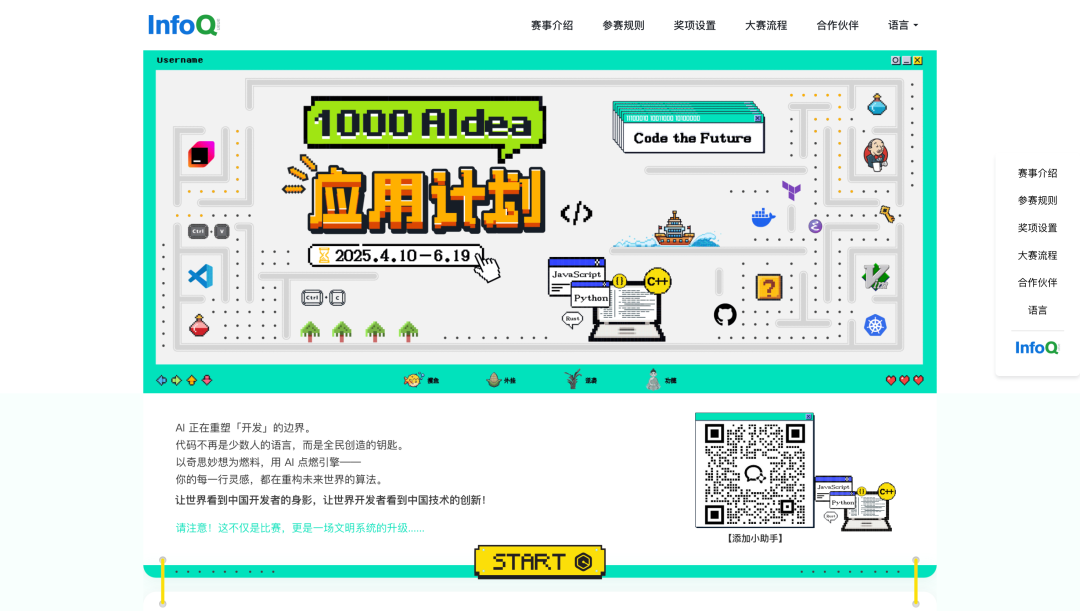
Let’s get the question information directly: https://sourl.co/G6XeJn, we can directly click “Ctrl+S” to directly take down the web page information of the competition question, of course, you can also select and copy it into the markdown text, this method needs to ensure that the text of the competition question is not in image format.
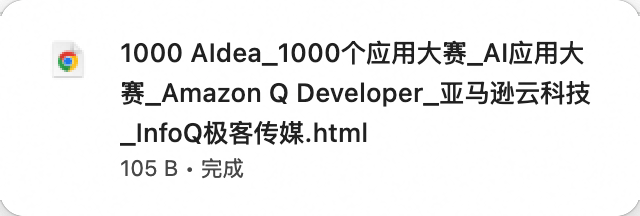
Next, let our Amazon Q read this question and give us an analysis of what kind of competition we need to participate in and what the recommended direction is.
Prompt template reference:
I have a question that I hope you can help me break down the core elements of it like a product strategist. Please follow the following logic to analyze
Problem definition: What is the core problem that this topic aims to solve? Can you help me summarize the problem description in one sentence?
Goal clarification: What is the ultimate desired result? Is the goal product delivery, user growth, or solving a pain point?
Judging criteria: Are there clear scoring dimensions or implicit success criteria? For example, technical feasibility, business value, user experience, etc.
Constraints: Are there specific scope of use, time constraints, technical frameworks, or team configuration requirements?
User perspective: From the user’s point of view, who is the core group of people served by this topic? What pain points or needs do they have?
Help me answer in a structured way, preferably summarizing each point clearly in concise and straightforward language, which is suitable for writing PRD or entering the brainstorming stage in the future.
The core design of this prompt is a referenceDesign thinking(Design Thinking) in the Problem Definition stageandProduct ManagerCommonly used 4W1H frameworks (What/Why/Who/When/How), while also leaving a lot of room for Amazon Q to use its knowledge and analytical capabilities to break it down.
You can adjust this template slightly and use it for different topics, such as adding context or adding specific topic stems, and AI can help you analyze it more accurately.
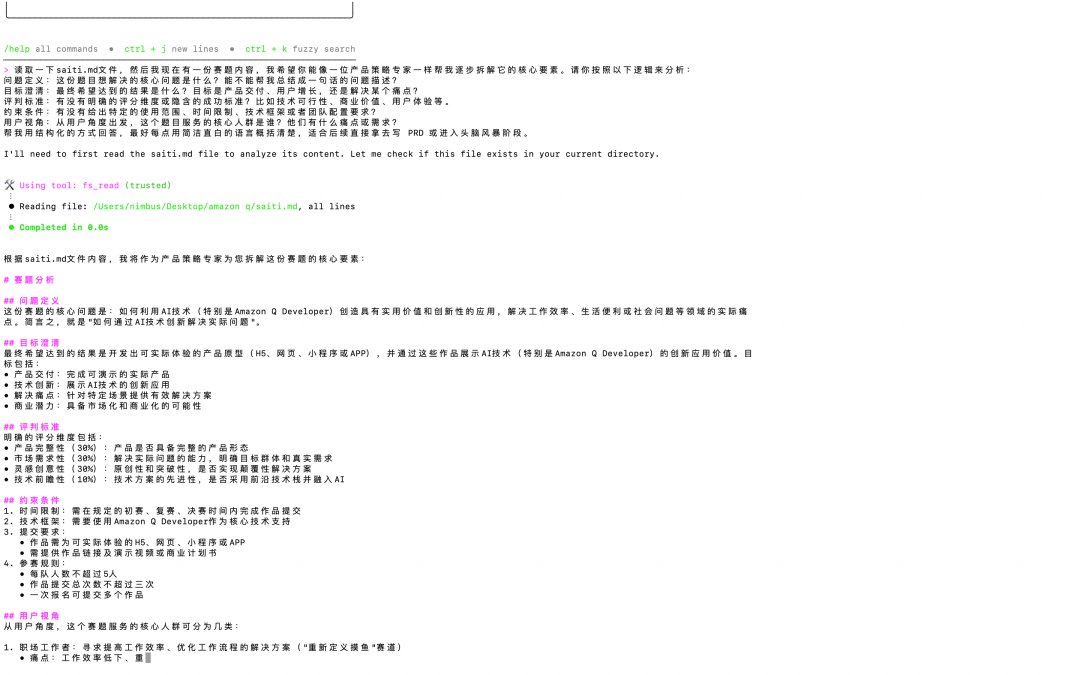
2. When you think of ideas, don’t think about them yourself
Let AI brainstorm for us
With direction, the next step is, of course, to find a way to solve the problem. But after all, the ideas that pop up in a person’s mind are limited, and sometimes it is easy to get stuck in and not get out. Tell AmazonQ and it will help you diverge your thinking from different angles.
For example, you can help you find inspiration from the direction of user needs, technical implementation, and business value, and you can also summarize some of the ambiguous points you mentioned more clearly. It’s like having a colleague who is not tired talking to you at any time.
Prompt template: Help me vent my thoughts and brainstorm solutions
Next, I would like to ask you to help me brainstorm some possible product ideas or solutions from different angles around the direction of the competition that we have already clarified.
Try to diverge from the following dimensions, each listing multiple directions or scenarios that can be explored:
User perspective: Who is the user? Where might their pain points be? Are there any new use cases to explore?
Technical feasibility: Based on the current mainstream large models, APIs, and tools, can there be new technical uses or combinations?
Scenario expansion: In addition to the solution to solve the problem directly, is there any way to “borrow strength”? For example, combining existing platforms and existing data flows?
Business and growth: Is there a design that balances conversion rates, user retention, and business models?
Existing solution optimization: Is there a similar solution on the market now? Can it be transformed and upgraded, and differentiated breakthroughs?
If you can, also help me summarize the core logic behind each idea in one sentence. The goal is not to do it in one step, but to open up as many ideas as possible and light up the blind spots.
The design of this prompt is based on several professional creative divergence models:
- SCAMPER(Replace, Combine, Adjust, Enlarge, Shrink, Replace, Reverse)
- Five-dimensional divergence method(User, Scenario, Technology, Market, Value)
- First principlesThinking method(Derive a new path from the essence of the problem)
You can add the description of the current question or the existing ideas at hand, and the effect will be better.
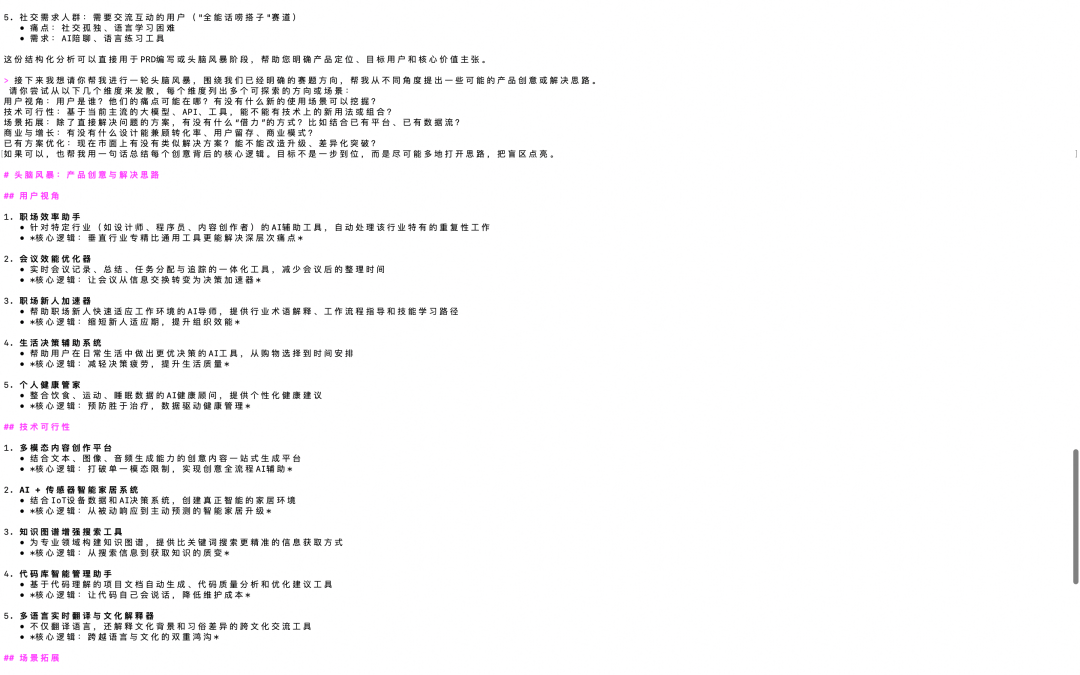
3. Find out what users really care about
For example, after brainstorming above, we finally selected a “social media content analysis strategist” scenario, so we should gain insight into what users care about more in this scenario and where our core focus is.
Let AI help us with insights
If you have user feedback, competitor data, or data reports, throw them directly to Amazon Q, and it can help you analyze which questions are repeatedly asked by users, which types of people encounter them most often, and which features may be overlooked but are critical. It will help you extract valuable insights from this clutter and tell you which direction to optimize or innovate.
Prompt Templates: Help me extract valuable insights from user feedback or competitor profiles
I now have a batch of information (including user feedback, research records, competitive product analysis reports, etc.), the amount of information is relatively large, and it is also more complicated, I would like to ask you to help me sort out these contents clearly, like an analyst who understands product and user research
Insight into the results. Please analyze it from the following perspectives:
High-frequency problem classification: What problems or needs are mentioned repeatedly? Can you help me divide it into topics or categories?
User group profiles: Which user groups are most concerned about these issues based on the content of the questions or feedback? Are there any demographic characteristics that can be subdivided?
Potential pain point mining: Are there any hidden problems that are not directly spoken but can be read from the expression?
Opportunity point identification: From the user’s point of view, what functions do they find inconvenient but do not do well with competing products on the market? Do we have a chance to cut in?
Experience differentiation suggestions: Are there any requirements that can be designed as differentiated highlights of our products?
Finally, please output these analysis results in a structured way, preferably in points, so that I can enter the stage of functional sorting and product solution design in the next step.
This prompt references typical analytical structures in UX research and product insights, such as:
- Affinity Mapping
- Jobs to be Done
- Pain-Gain Map
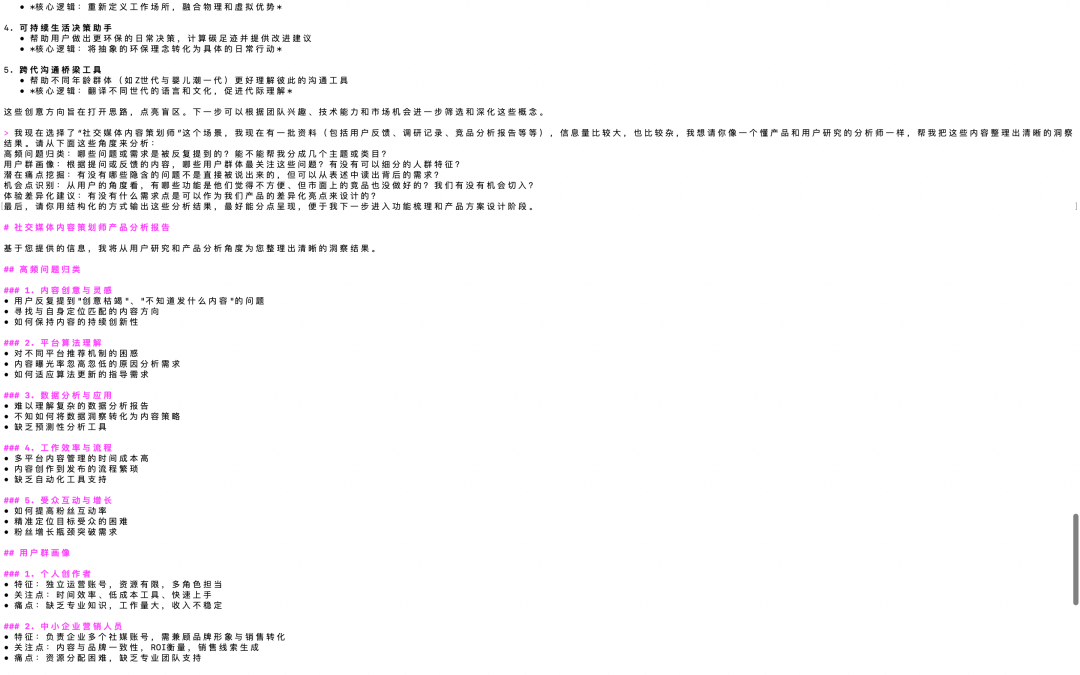
4. How to design the function, let it help us sort it out
Ok, we have basically clarified the user’s portrait and pain point information above, and the next step is to sort out what the functional modules of our MVP (minimum viable product) are based on these scenarios, and then we need to have a clear list of requirements.
Let AI help us sort out our functional needs
When you have a general product idea or solution direction, the next step is to break it down into specific functions. Based on the results of the previous analysis, AI will help you list “what functions should this product include”, “what problems each function solves”, and “how users operate step by step”.
This piece is particularly good at turning vague ideas in our minds into clearly written functional points, which is also convenient for design and development.
Prompt template: Help me break down my product idea into a clear list of functional requirements
I now have a preliminary product idea (or a clear goal/scenario), and I hope you can help me sort out the core features that this product should include based on our previous analysis. Please help me sort it out step by step from the following dimensions:
Feature list: What are the main functional modules that this product should include from “user first use” to “complete the main task”? Please list each piece and briefly explain what it does.
User operation path: From the user’s point of view, how does the entire process come down step by step? In which link does each function point appear?
What does each feature solve: Help me align: What is the purpose of each feature point? Which user pain point or need is it addressing?
Logical relationships between functions: Are there dependencies and priorities? Which are the core features and which are accessibility?
MVP perspective convergence: If I were to make a minimum available version (MVP) first, what features should I retain? Which ones can be given up first?
Please organize your answers into clearly structured paragraphs or tables so that I can use them directly for PRD or to communicate with the team about the design plan.
This prompt is designed with reference to classic methodologies in product planning:
- Function vs. Need)
- User Journey Mapping
- MoSCoW Priority Model (Must, Should, Could, Won’t)
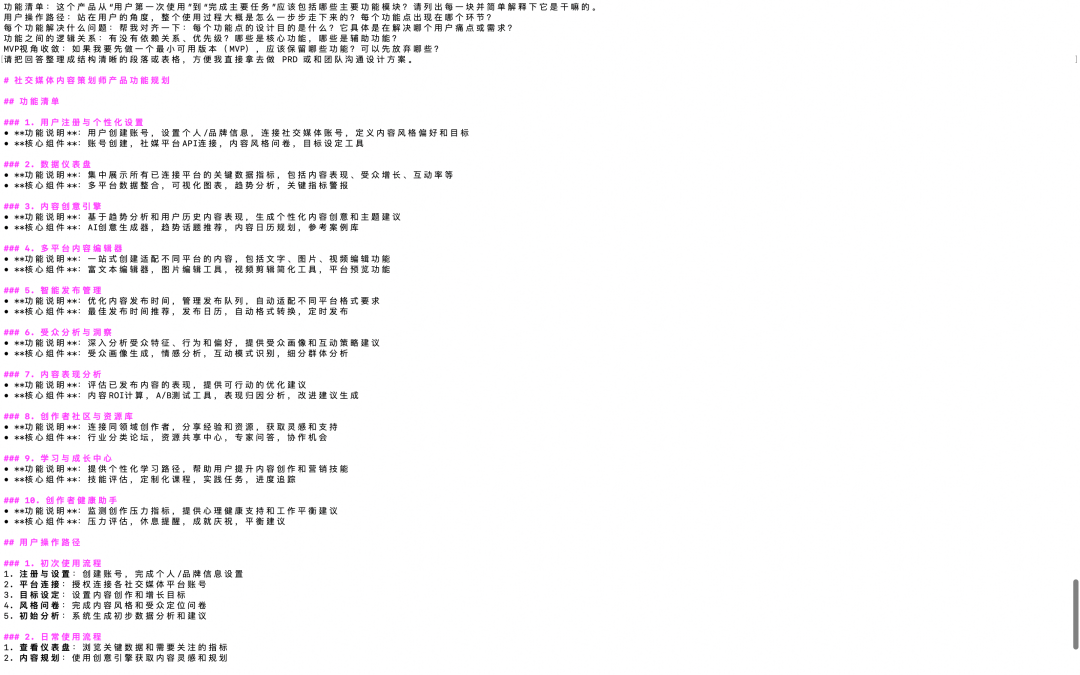
5. Writing PRD can also be done by it
Let the AI generate oneAIUnderstandablePRDdocumentation
Now writing PRD is not only for people to see, but also for AI tools to understand. AI will automatically generate a well-structured product requirements document based on the functions we talked about earlier. It includes key points such as function description, user flow, and interface logic. The document logic it writes is very clear, and it can be used directly to synchronize with the team or connect with other intelligent tools.
Prompt template: Help me generate a clearly structuredAIreadablePRDdocumentation
I already have a basic idea and a list of features for the product, and now I would like to ask you to help me compile a PRD (Product Requirements Document) that AI can understand and continue to execute. This PRD should not only be understandable, but also consider the clarity of the structure and the standardization of the format, so that it is easy to access automated processes or intelligent tool calls in the future. Please output according to the following structure:
Product background and goals: Briefly describe what problems the product wants to solve, what scenarios it serves, and what its core goals are.
List of core functional modules: List the name, function description, and usage scenarios of each functional module, and it is best to add a sentence “The problem solved by this function”.
User flow chart (text version): From the user’s perspective, describe the user’s operation path from entering the product to completing key tasks (serial numbers can be marked step by step).
Input/output of each function: Clearly list what the user or system inputs and what the desired output results are, suitable for subsequent interaction with large models or API docking.
Interface requirements (if any): Explain whether each function point needs interface support, and if so, explain the interface purpose, call method, and data structure requirements.
Boundary conditions and exception handling: List common boundary conditions and exception scenarios to explain how the system should respond.
Please format it clearly by module, structure the content as much as possible, avoid scattered descriptions, and preferably output in Markdown or tabular format for future reuse by other intelligent tools or engineering teams.
Finally, save to the current folder and store it in MD format.
This prompt incorporates:
- Machine-friendlyPRDWriting method(Clear structure, module segmentation, clear data flow)
- Six elements of the product(Target, User, Function, Process, Data, Boundary)
- Grammar habits for automated system understanding(e.g. Markdown expressions, clear field naming, clear input-output separation)
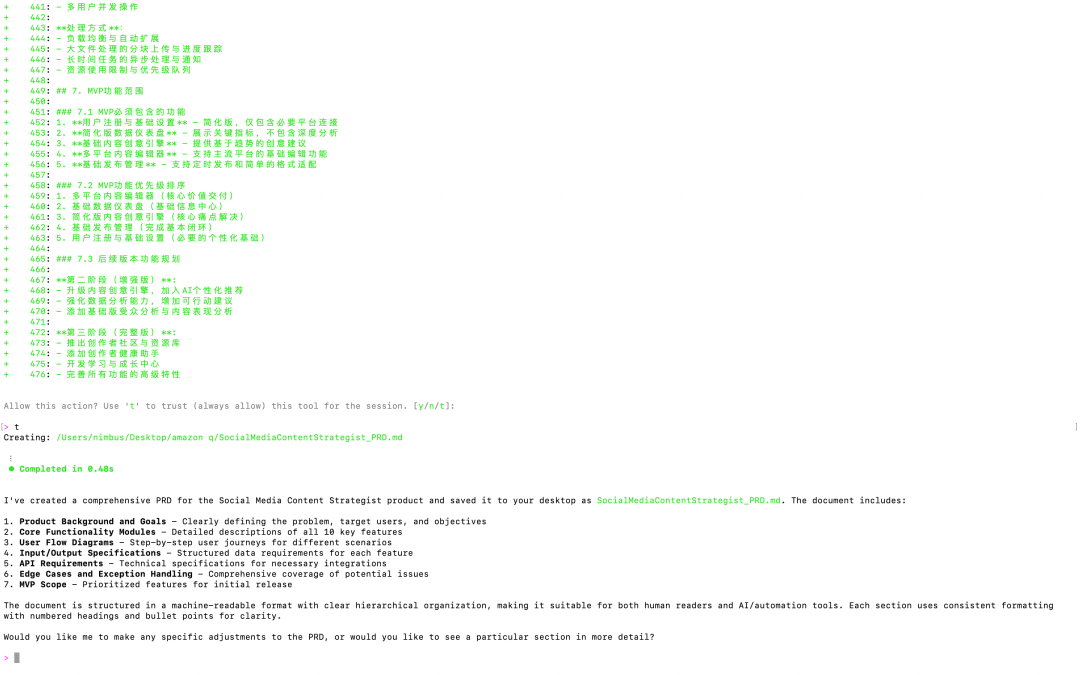
6. Let the model know what we want the interface to look like
Let the model know what we imagine the interface to look like, using FigmaMCPJust put the Figma link in it.
How do I configure MCP for Amazon Q? Enter this command directly into the terminal to create a json file for MCP:vi ~/.aws/amazonq/mcp.json。
After the creation is completed, we paste all the relevant MCPs into it, mainly using figma’s MCP service, after the configuration is completed, you can also directly ask Amazon Q which MCP services are currently available.

More MCP services can be found in mcp.so or in ModelScope.
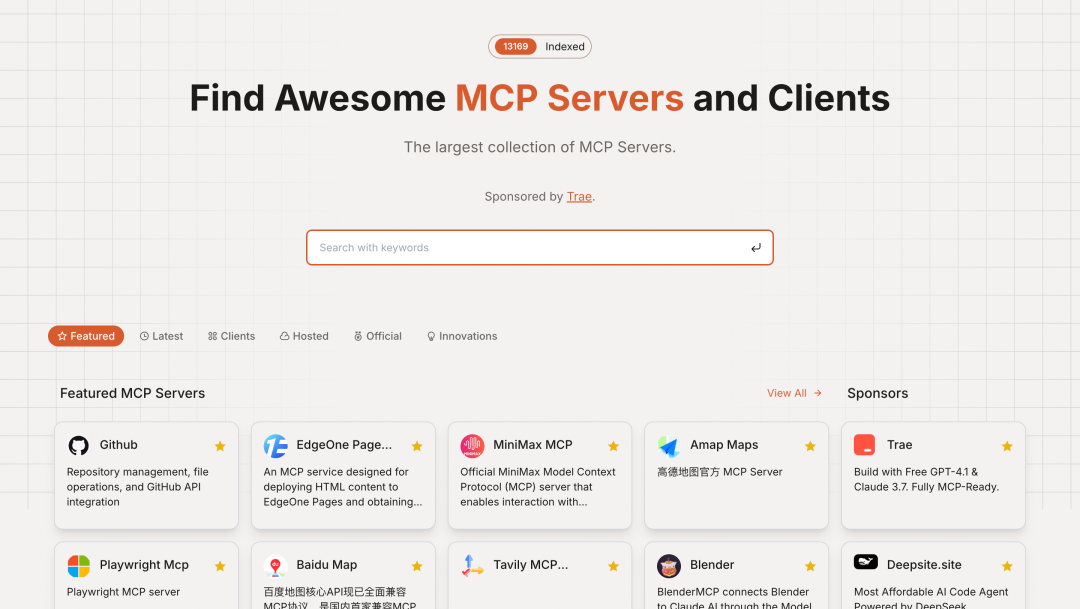

Sometimes we already have a general image of the product in our minds, or even draw a page on Figma, and at this time, we can let the model directly “look at the picture and speak”. We only need to drop the design link of Figma to it, and it will automatically recognize the page structure, component types, interactions, and other details through the MCP service.
We can find some public image design resources in the Figma community, and then like the style layout, etc., of course, the closer the better, just like we want to make a content creation tool, we will look for similar design resources, of course, it is difficult to find the same touch for very subdivided needs, in fact, it mainly depends on what style you like can be directly visually described.


The biggest advantage of this step is that the model understands the interface in the same way as a human, knowing which is the button and which is the input box, and knowing what will happen when the user taps it. Later, if you ask it to write front-end code or generate interaction logic, it will be much smoother, saving us from explaining each function again.
Prompt is very simple:
Combined with my figma draft link (https://www.figma.com/design/WXpW4QN4xFIeDVdZ7uqppm/Minimalistic-Social-Media-Templates–Community-?node-id=29-1239&t=fyrkseULN35IUmeL-4), read my prd documentation, Help me implement this function, follow the Tailwind Css design specification, use CND icon replacement, and use Unspalsh image to replace the corresponding image information.

7. If it wants to be connected to the system, the interface document must be prepared
Prepare the AI for itAPIdocumentation
If we want it to help us do more hands-on work, such as calling databases and retrieving user information, we must first give it API documentation. As long as we write the interface description, parameter rules, and request method clearly, it can “learn” how to call these services, and then it can automatically help us write code, pull data, and generate content without us manually connecting each link.

We have also shared with you before how to directly give the API document of the large model step by step, and then let the large model read the content that can be docked.
8. When the front is ready, let it start working
Let the AI start reading the document and do the work for us
Once the PRD and interfaces are in place, Amazon Q can be officially “put on board”. We can directly tell it to read our requirements documents and API documents, and it can automatically process according to the documents, truly stringing analysis, design, and development together.
We have already let it work directly, and you can see that it has released a basic version of the content:

Let’s also take a look at the effect of the final run:

9. You don’t have to write the product introduction yourself, just leave it to it
Let AI help us write a product introduction document
There are also many template references in our work submission, and we can fill in the relevant content according to the outline of the template.
When the product is made, there must be an external or internal introduction material. At this time, Amazon Q can also write it, and it can summarize it into a decent introduction based on our previous requirements documents, user scenarios, and product features. Whether it is for team members or for internal review, the content structure it writes is quite professional, not verbose, and the focus is very clear.
Prompt Template: Help me write a concise and professional product introduction document
I now have a completed product, and I want you to help me generate a clear product introduction document based on previous requirements documents, user scenarios, and feature descriptions. The goal of this document is to give external or internal teams a quick understanding of the core values, features, and usage of our products. Write it according to the following structure:
Product Overview: Briefly introduce what the product is, what problems it solves, what kind of users it is for, and convey the core value of the product concisely.
Target User Group: Explain who the main users of the product are, how it meets their needs, and why it appeals to these users.
Core Functions: List and briefly describe the main features of the product, outlining its purpose and goals in one or two sentences for each feature point.
Use Cases: Give a few typical user usage scenarios or usage processes to help you understand how the product solves problems in a real-world environment.
Technical architecture and innovations: Briefly describe the technical highlights, innovations, or unique technical realizations of the product to help highlight the product’s competitiveness.
Market Positioning and Competitive Advantage: Analyze the product’s positioning in the market, as well as its advantages and differentiation over competing products.
Future development and optimization direction: Briefly introduce the future development plan of the product and the possible functional expansion or optimization direction in the future.
Please keep the document structured, focused, not verbose, and concise and clear, suitable for use as internal reports, external introductions, or review materials.

10. Publicity copy can also be packaged
Let AI help us with product marketing copy
If a product wants to be brought to the market, it must have a copywriter who can fight.
This can also be left to Amazon Q. You tell it which platform you want to post on and who the target audience is, and it can help you write promotional content that fits the scene.
Whether it’s a formal introduction or a more relaxed social media copy, it can automatically adjust the style according to the tone and channel, without us having to change it repeatedly.
Prompt template: Help me generate marketing promotion copy that fits the scene
I need a marketing copy for the product right now. Please help me write copy suitable for different platforms based on the background information and goals I provide, ensuring that the copy can attract the target users and adjust the appropriate tone and style. Here are the requirements for copywriting:
Platform: Which platforms will the copy be published on? For example, official website, Weibo, WeChat public account, Douyin, Xiaohongshu, etc. Adjust the copywriting style and tone according to the platform’s characteristics.
Target audience: Who is my target audience? What are their needs, interests, pain points? (such as young people, business managers, technicians, etc.)
Types of copywriting: What type of copy do you need to write?
Formal introduction copy: Suitable for official occasions such as official websites, product manuals, and corporate publicity.
Easy Social Media Copywriting: Suitable for highly interactive channels such as Weibo, Moments, and short video platforms.
Core selling points: What features or benefits of the product are most worth highlighting? (e.g. time-saving, efficiency, cost reduction, innovation, etc.)
Call-to-action (CTA): What action do you want users to take when they see your copy? For example, click to buy, sign up for the experience, learn more, etc.
Generate copy based on these requirements to ensure that there are corresponding style changes for different platforms and audiences. It would be better if multiple versions were available, such as short and long.
The design of this prompt is referencedMulti-channel strategy in copywritingandPersonalized marketing driven by user profilesand make different tone adjustments to ensure that the copy is in line with the characteristics of the publishing platform.
Let’s also take a look at the preview effect:

In the past, when making products, from research, conception to implementation, we had to climb a lot of mountains.
Now with the help of AI, we only need to speak out our ideas, and it can accompany you all the way to get things done.
This whole process is not a demonstration, we have actually fought it ourselves, and I will continue to share the current version 1.0 iteration into a more stable and mature version with you.
I hope that after reading it, you can also try to use these methods in your own projects, really use AI, save unnecessary time, and focus on the most valuable creativity.
Together, we use AI to turn ideas into works.




